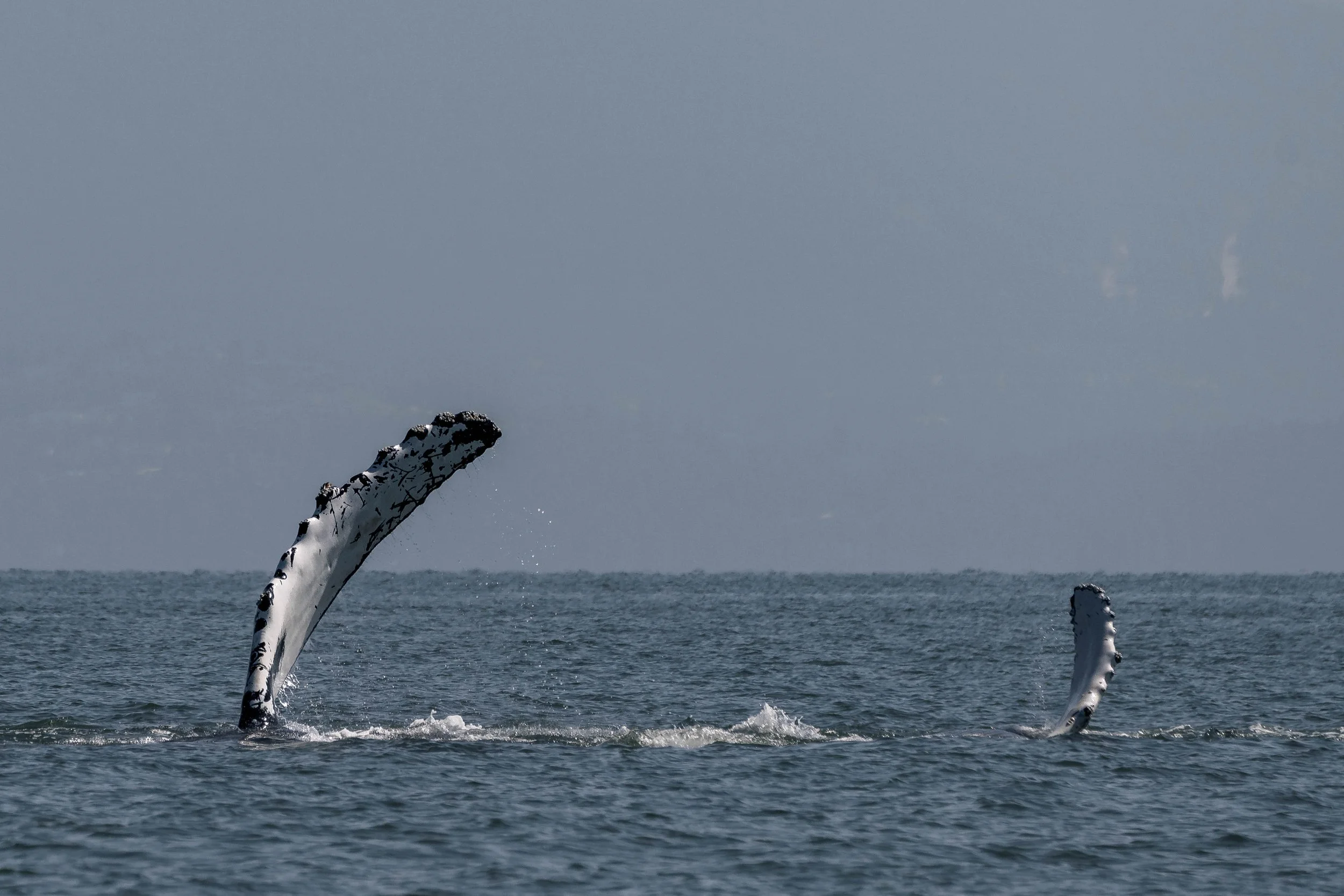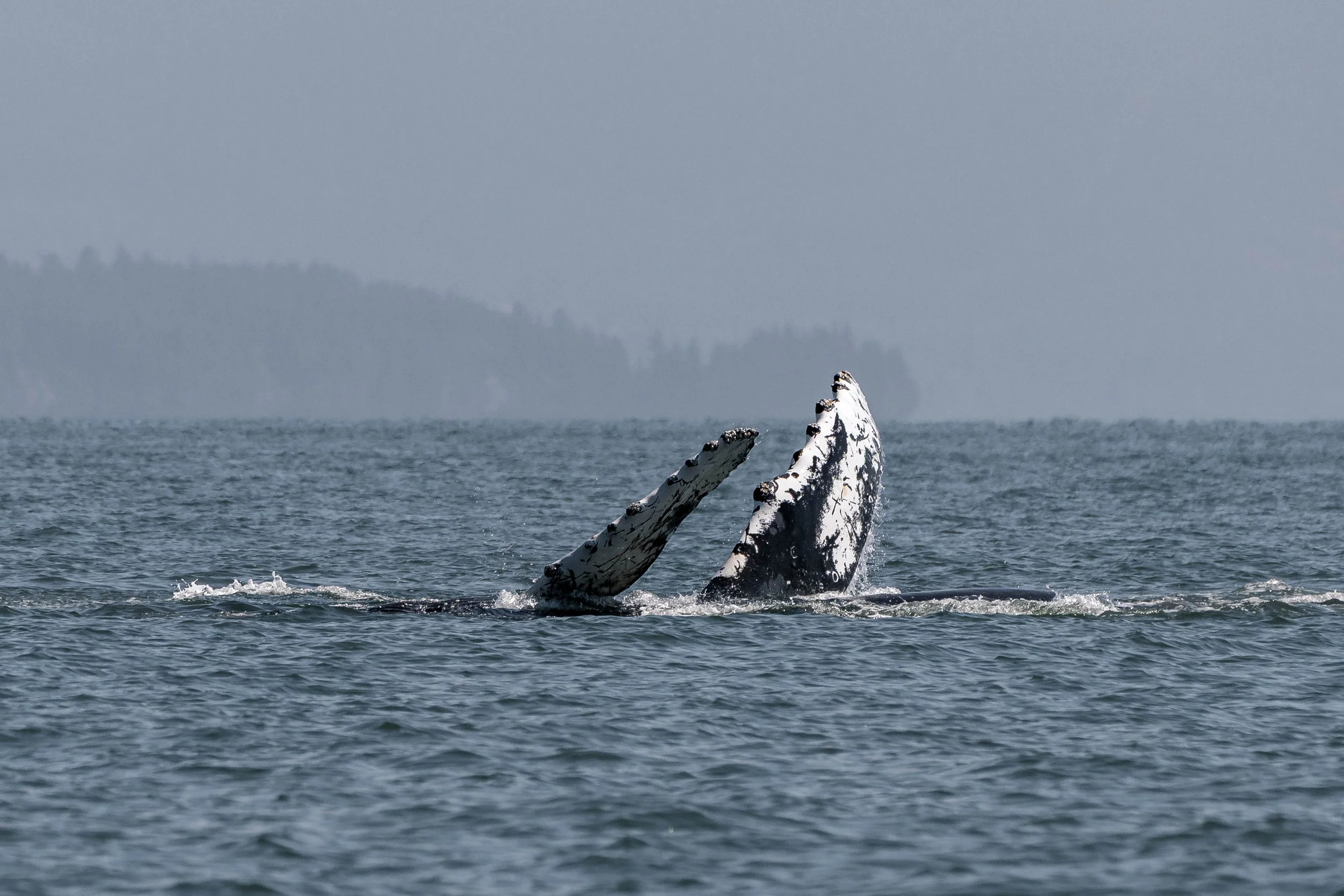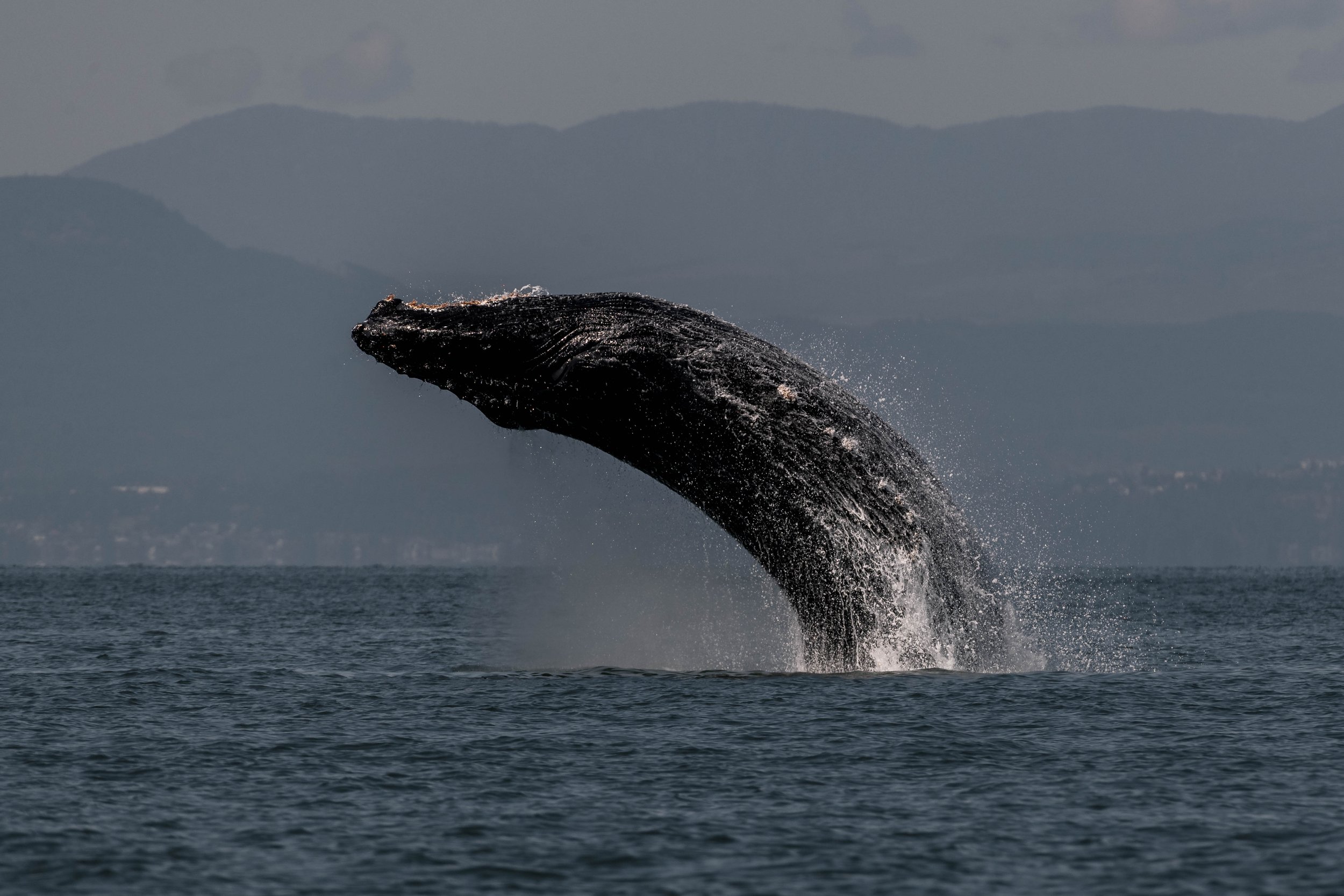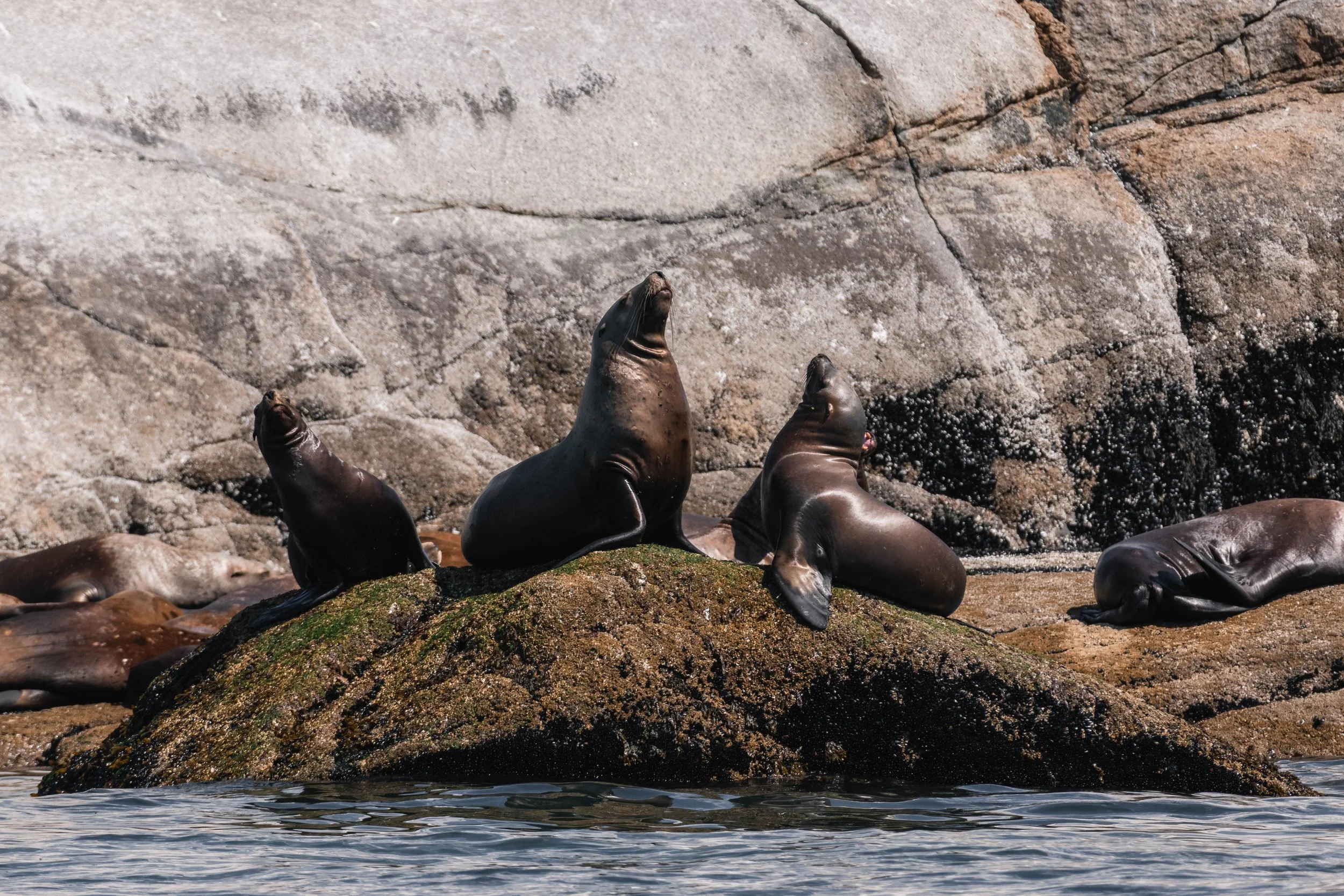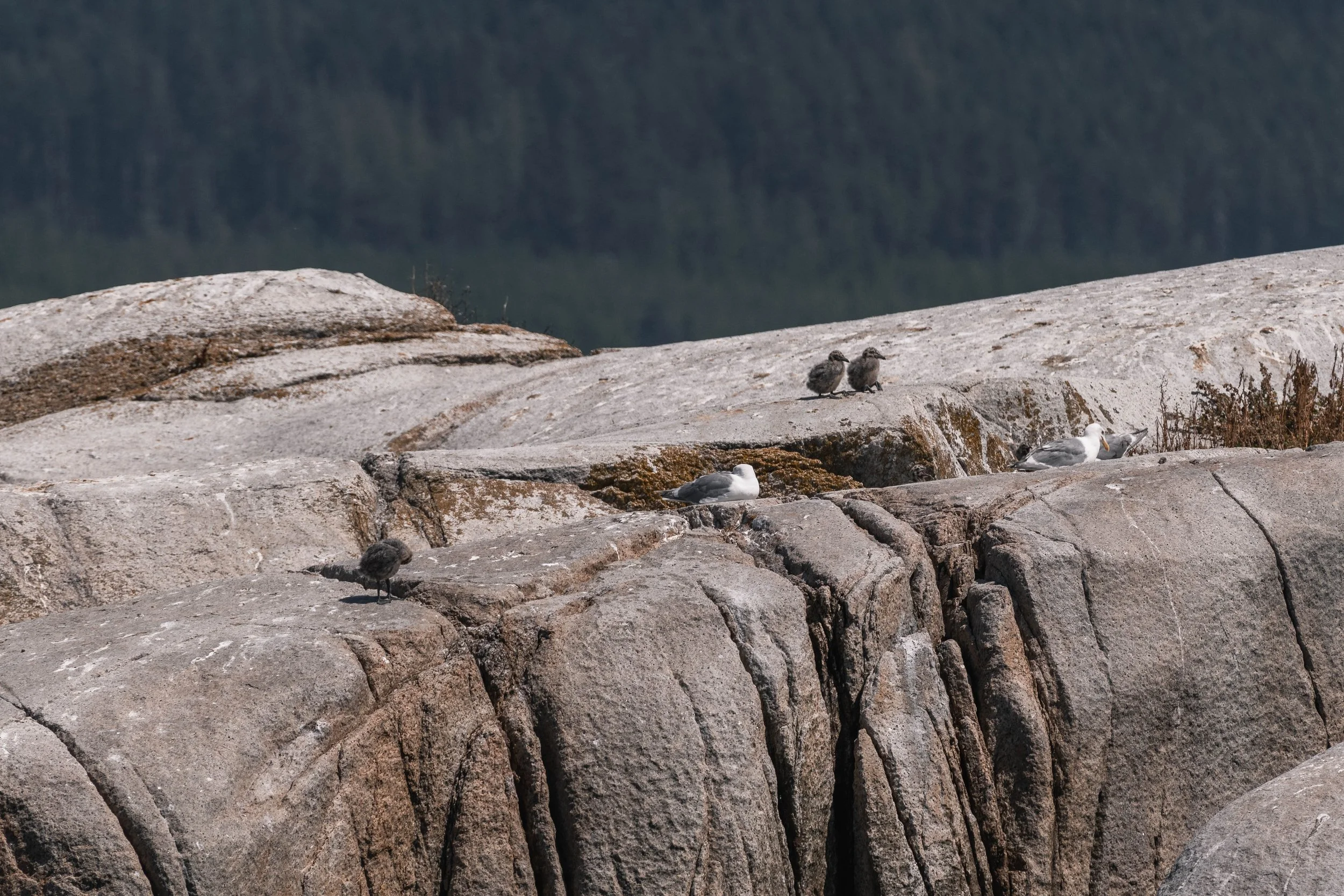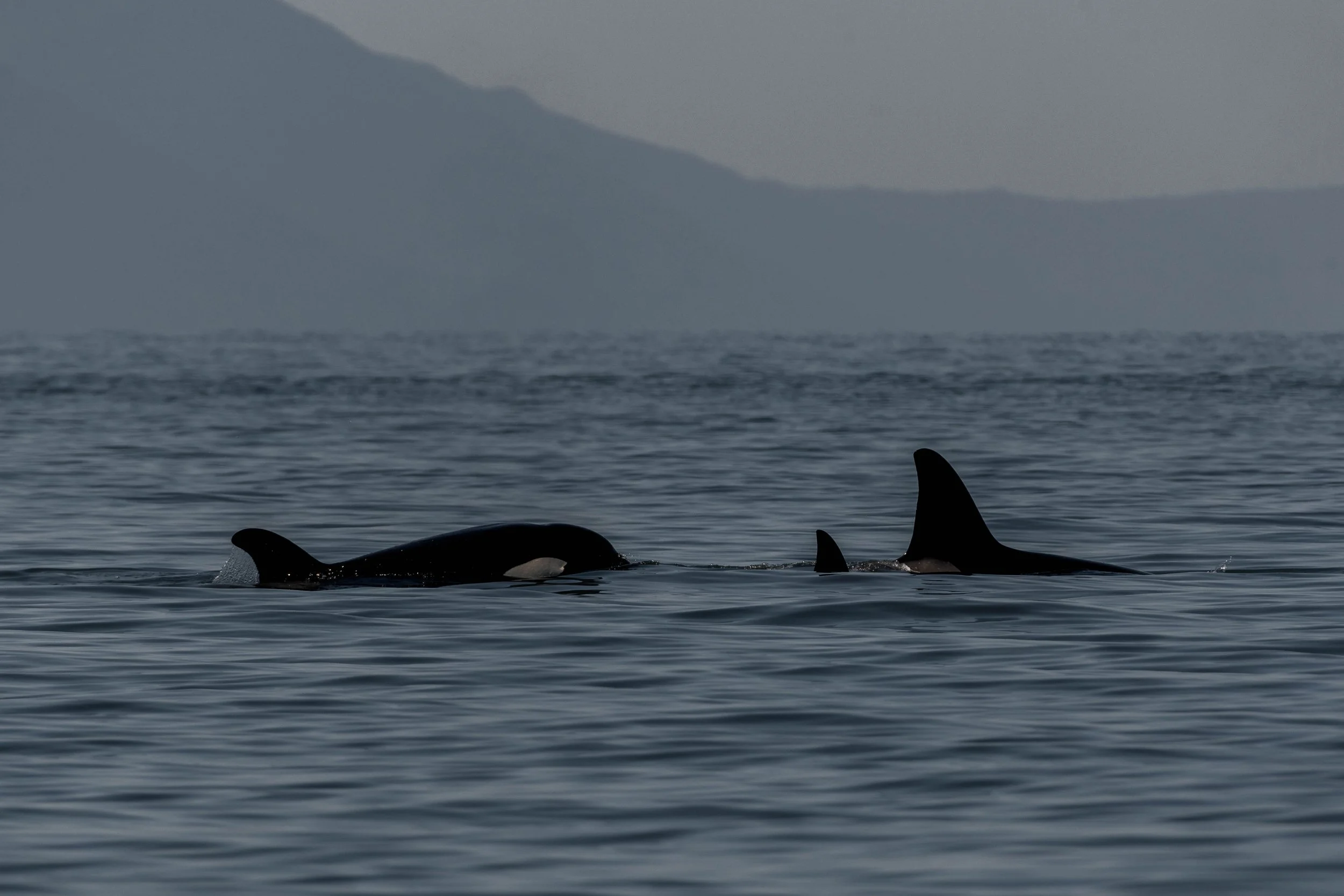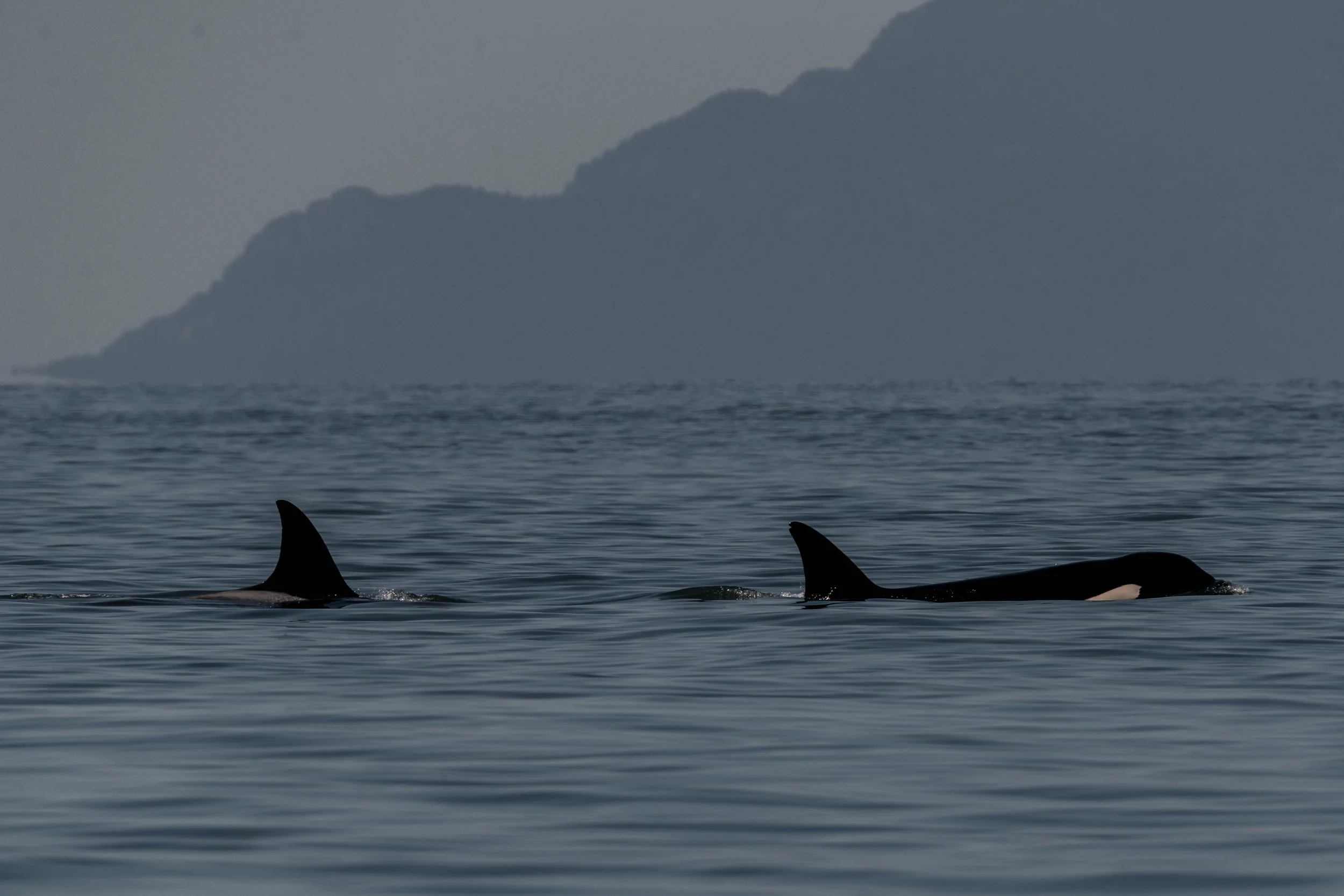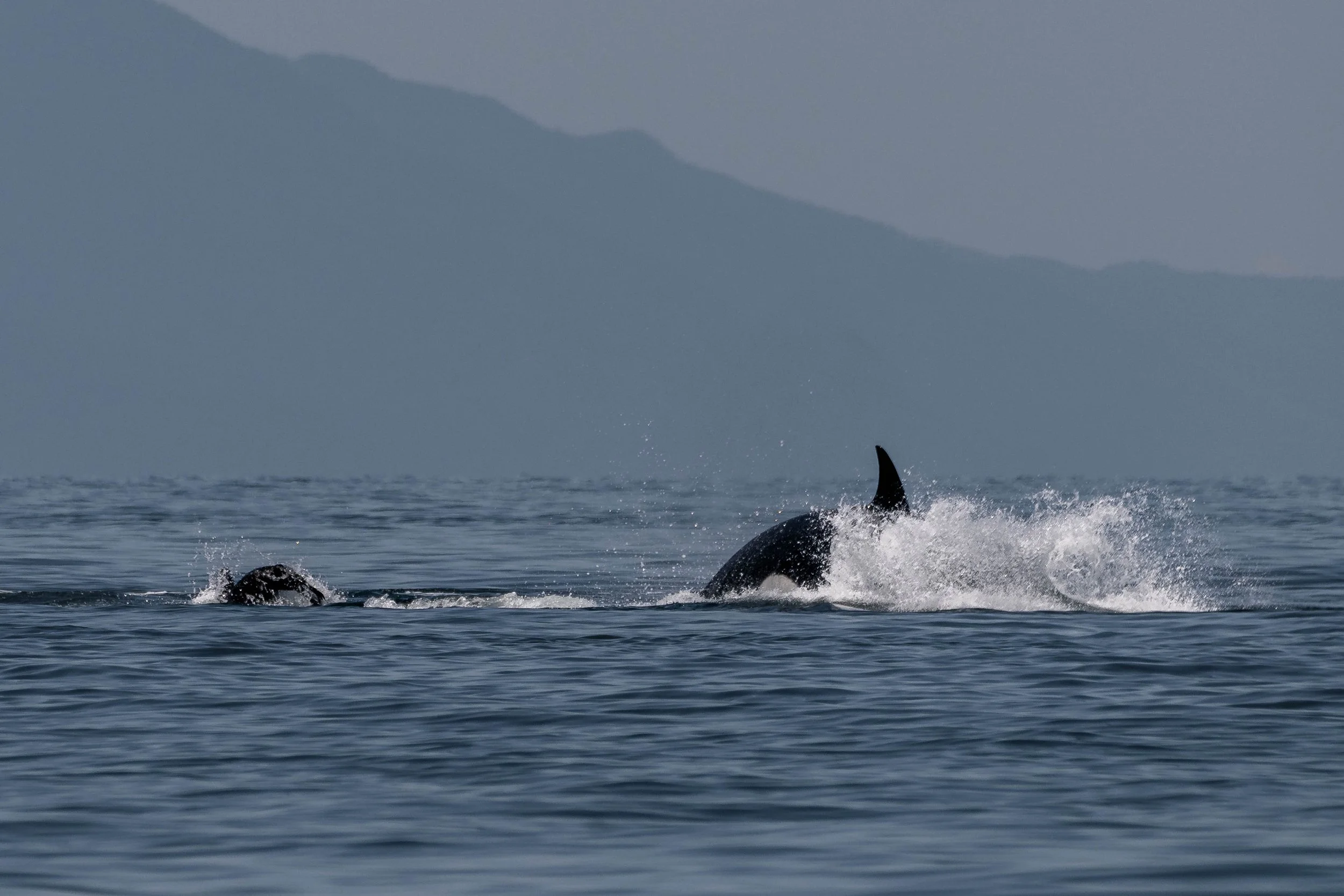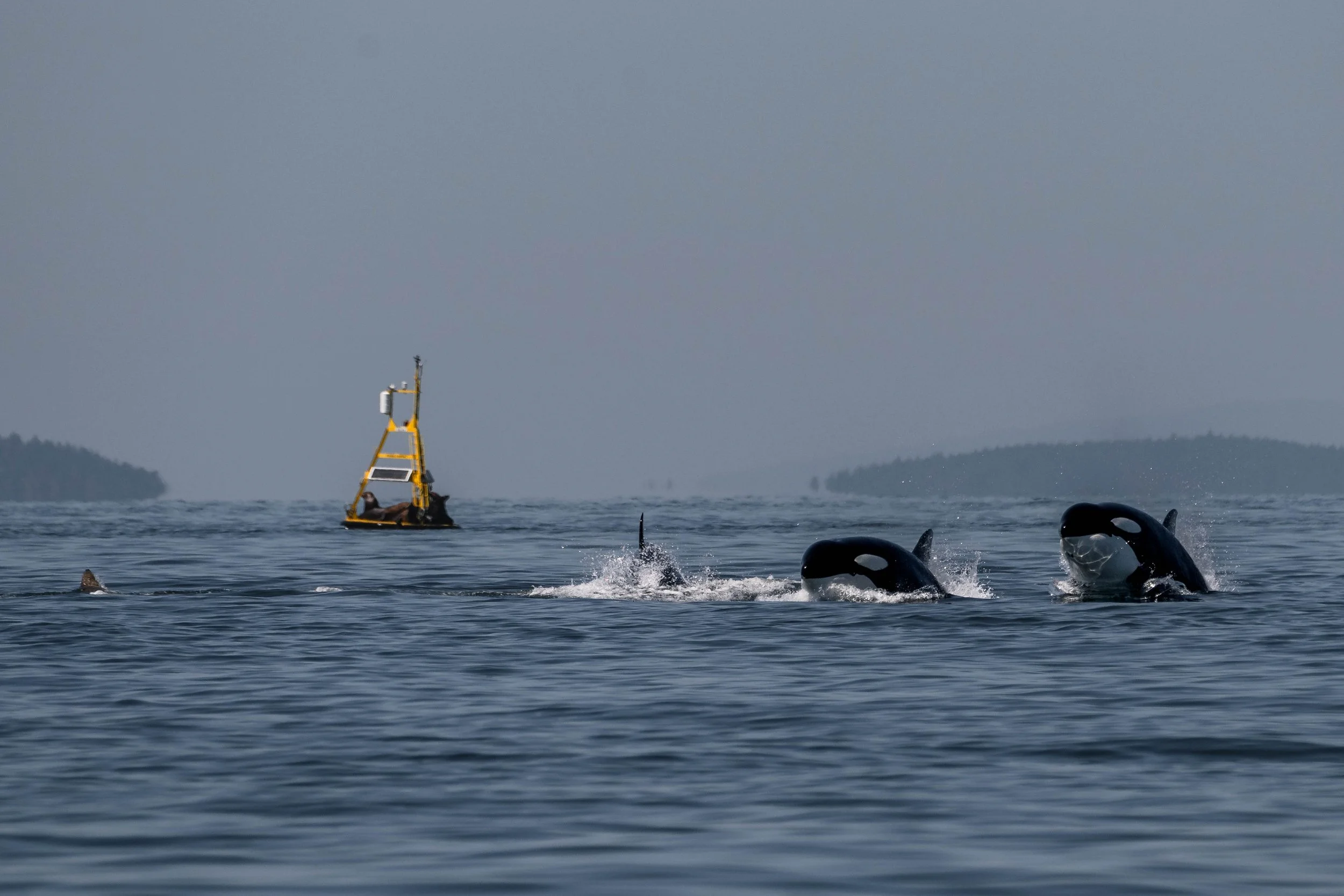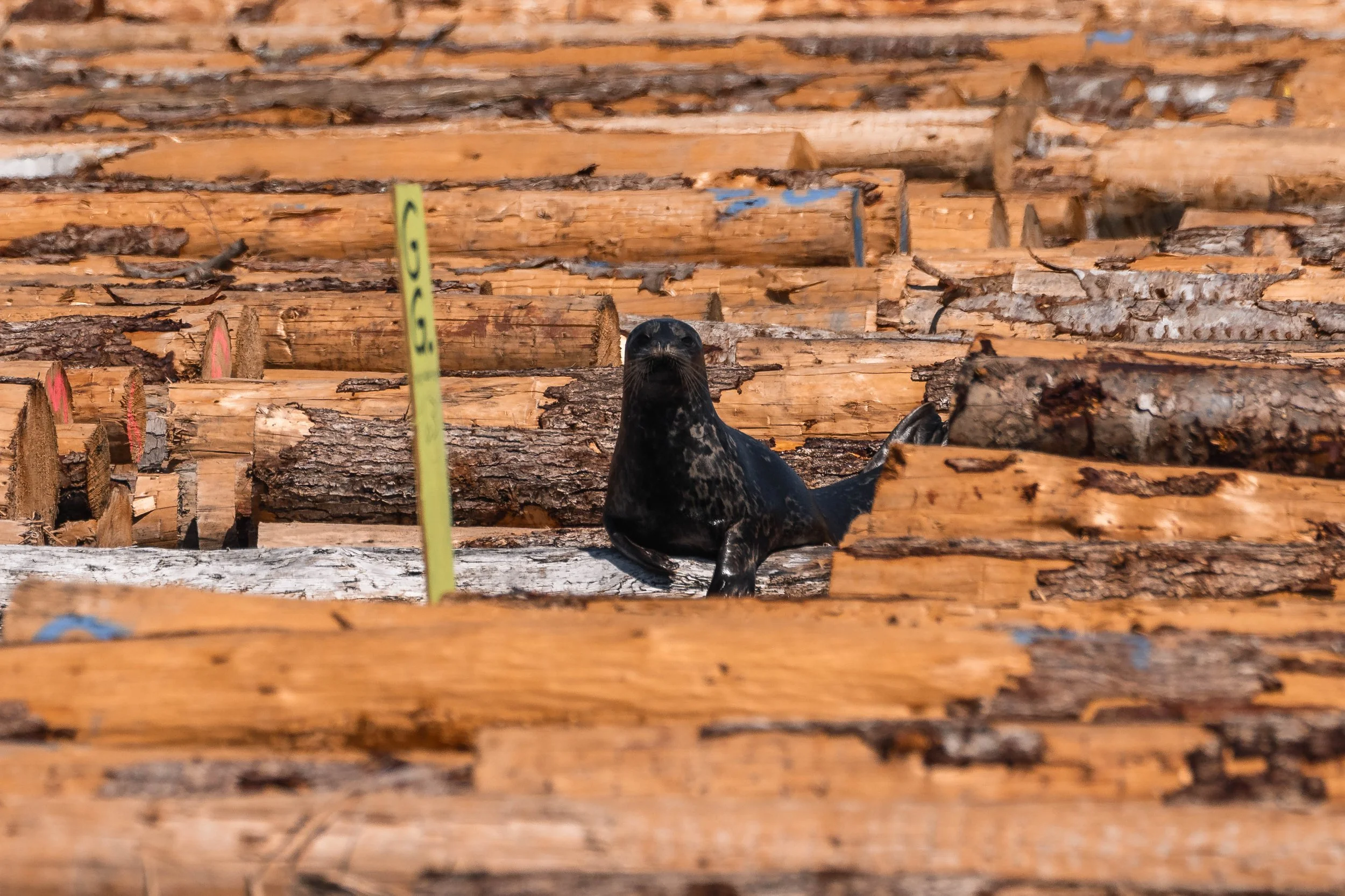July 21, 2025, 10:30 AM - Breaching Humpbacks, and the T036As
The sun was shining overhead, and the winds were calm as we set sail from Nanaimo. We headed into the Strait of Georgia, where there have been a lot of whales spending time lately. We spread our fleet out, with the different boats beginning their search in different areas, increasing our chances of encountering something. It seems that this method worked out perfectly, as we ended up spotting some splashing in the distance, which suggests there is an active whale in the area! The splashing seen from our boats turned out to be two different groups of humpbacks active at the same time, so our first sightings differed between the boats. Two of the boats ended up spotting Vanta (BCY1274), who was breaching, and the other boat found Split Fluke (BCX1068) with her 2025 calf! All three of these whales were being very active, with their pectoral fins being lifted out of the air and slapped back onto the water, rolling around in the waves, and even breaching fully out of the water. For Split Fluke and Vanta, the energy requirements of this action are huge, taking the most energy for a single action of anything else in the animal kingdom. To put it in perspective, the amount of energy used for one of these adults to breach is the same amount that it takes for a human to run an entire marathon! Humpback do consume a huge amount of food on a daily basis during the summer, about 1 - 1.5 tonnes, so it’s only about 2% of their daily energy, but that’s still impressive for a single action. The calf, being much smaller, isn’t going to have as much energy used overall to jump out of the water, but it still is a significant amount of their daily energy.
With all of the energy that it takes, the question becomes, why would they do it? There are three leading theories as to why the humpback whales might be jumping out of the water, as we witnessed today.
Parasite Removal - Each humpback can carry up to 500 pounds of parasites on them at any given point. Three species make up these parasites: Humpback Whale Acorn Barnacles, Humpback Whale Gooseneck Barnacles, and Humpback Whale Lice. Although the barnacles can provide some benefits, by acting like armour during defence, they also increase drag for the whales, making them have to spend more energy to move through the water. This is why they sometimes have to knock them off!
Long Distance Communication - The impact of a humpback whale hitting the water is very powerful, not only creating a big splash, but also a loud noise along with it. Sound waves can travel much faster and much farther under the water thanks to the density of the molecules and the lack of larger obstacles. We were able to hear it above the surface quite easily, even watching them at at least 200m distance, meaning that animals underwater much further away would be able to as well! We aren’t sure exactly what they would be communicating while breaching, but our best guess is " I’m over here and ready to socialize if you are!”
FUN! - Breaching is quite often seen alongside other surface behaviours when the whales are acting more social. If you have ever been lucky enough to see them jumping, you would probably agree that it looks like they’re enjoying themselves while they do it!
No matter the reason, we are always thrilled when we get to witness this sort of power from these gentle giants! After spending some time with them, one of our boats left Split Fluke and her calf behind and started to head towards Vanta as well, but another pair of humpbacks popped up instead, so they stuck around to watch Scuba (BCY1225) and Orion (BCX1251) travelling together. In addition to Orion and Scuba, one more humpback made an appearance for this boat: Anvil (BCZ0410)! Each of these whales seemed to be just transiting through the area, moving quite quickly without much significant dive time in between each surface.
With a quick stop to view some Steller Sea Lions, we had heard word that another boat had come across a pod of orca not too far from us, so we decided to head that way and see if we would be able to spend some time with them. Sure enough, it didn’t take long to spot the iconic black dorsal fins of the orca cutting through the calm water ahead. Thanks to some very distinct dorsal fins, we immediately recognized this pod as the T036As, a group of 6 orca that usually travel together.
T036A Leland ♀ (1990)
T036A1 Tierna ♀ (2005)
T036A1A (2022)
T036A2 Kailas ♀ (2012)
T036A3 Storm/Mike III ♂ (2015)
T036A5 ♂ (2021)
These whales are an interesting family, since they are likely right on the edge of having one of their members, T036A1 Tierna, disperse from the rest of the pod. Since the Transient Orca are hunting mammals, and other mammals are also quite intelligent, they need to be quite stealthy to be successful. Part of this is keeping the pod sizes small, to help avoid detection as they move through the waters. So, this means that with Tierna and Leland still having kids, this pod will get much too big to keep their stealth up. Tierna will likely start to travel on her own, becoming a matriarch of her own pod consisting of her kids. This doesn’t always happen since females go through menopause. If Leland weren’t having more kids of her own, it might make sense for her to help her daughters raise their kids, but with so many reproductive-aged females, it’s unlikely that this pod will stay travelling together for much longer. Although sad, it’s actually great for the whales since having higher hunting success makes for happier whales! And it seems this group is still having no issues sneaking up on food, since one boat saw them initiate a Steller Sea Lion hunt in the last few minutes of their time with them. While we couldn’t stick around long enough to know if they were successful, seeing it start so strongly was an excellent sign.
The tour ended with a look at the Gabriola Bluffs, where we saw the birds that spend their time there, before we returned to Nanaimo. It was such a special day getting to see both species of whale, plus so much action from the humpbacks! Throughout the tour, the onboard Marine Naturalists Val Watson, Aly Kohlman, and Desarae Poier captured some fantastic photos of all this amazing wildlife, which is available for your viewing below!
Split Fluke and calf
Split Flukes dorsal fin (left) with the calf’s pectoral fin in the air! Photo by Val Watson.
Split Fluke lifting her tail to dive, with her calf breaching beside her. Photo by Val Watson.
Split Fluke showing her calf how to breach! Photo by Val Watson.
An interesting angle of Split Fluke breaching. Photo by Val Watson.
The calf breaching beside their mom, Split Fluke. Photo by Val Watson.
Split Fluke with her pectoral fin in the air. Photo by Val Watson.
A very cute comparision between the pectoral fins of Split Fluke and her calf. Photo by Val Watson.
Like mother like child, pectoral fins in the air! Photo by Val Watson.
You can see how scarred up both Split Fluke and her calf are. Photo by Val Watson.
Vanta
Vanta breaching! Photo by Aly Kohlman.
A very cool angle of Vanta breaching. Photo by Aly Kohlman.
Vanta breaching. Photo by Desarae Poier.
Vanta swimming on their side with a pectoral fin in the air. Photo by Desarae Poier.
Vanta’s pectoral fin. Photo by Desarae Poier.
A great look at Vanta’s ventral grooves as they are on their side. Photo by Desarae Poier.
A beautiful breach from Vanta. Photo by Desarae Poier.
Vanta breaching, showing off their flexibility. Photo by Desarae Poier.
Scuba and Orion
Orion going for a dive, giving a fluke waterfall. Photo by Val Watson.
Scuba going for a dive, you can see the notch in his peduncle from previous entanglement. Photo by Val Watson.
Orion going for a dive. Photo by Val Watson.
Anvil
The underside of Anvil’s tail flukes. Photo by Val Watson.
Anvil creating a fluke waterfall. Photo by Val Watson.
Vanta going for a dive. Photo by Desarae Poier.
Other Wildlife
A great look at the Sea Lion’s eye. Photo by Val Watson.
Steller Sea Lions posing on the rocks. Photo by Aly Kohlman.
Some baby seagulls on the White Islets. Photo by Aly Kohlman.
Look at the whiskers on these Steller Sea Lions. Photo by Aly Kohlman.
Steller Sea Lion on the White Islets. Photo by Desarae Poier.
The T036As
T036A1A surface behind mom, T036A Tierna. Photo by Val Watson.
T036A5 Squall surfacing behind T036A3 Mike. Photo by Val Watson.
T036A3 Mike surfacing. Photo by Aly Kohlman.
T036A1A Drift and T036A1 Tierna surfacing side by side. Photo by Aly Kohlman.
The whole family surfacing together. From left to right, T036A3 Mike, T036A2 Kailas, T036A1 Tierna, and T036A1A Drift. Photo by Aly Kohlman.
The two most distinct members of this group surfacing together, T036A1 Tierna in front and T036A2 Kailas behind. Photo by Aly Kohlman.
A great look at T036A2 Kailas. Photo by Aly Kohlman.
T036A5 Squall and T036A3 Mike surfacing together. Photo by Aly Kohlman.
T036A Leland surfacing with T036A2 Kailas. Photo by Aly Kohlman.
T036A1 Tierna surfacing with T036A1A Drift. Photo by Desarae Poier.
T036A5 Squall’s eye patch beside brother, T036A3 Mike with T036A2 Kailas just in front of them. Photo by Desarae Poier.
A great look at T036A1 Tierna’s notches. Photo by Desarae Poier.
T036A2 Kailas, T036A1A Drift, and T036A Tierna surfacing together. Photo by Desarae Poier.
T036A1 Tierna initiating the hunt. Photo by Val Watson.
Family photo with all the T036As during the hunt. Photo by Val Watson.
The sea lion on the left, and T036A Leland on the right. Photo by Val Watson.
T036A1 Tierna surfacing with her daughter T036A1A Drift at her side. Photo by Val Watson.
T036A Leland (right) surfacing with her oldest daughter, T036A1 Tierna (left), at her side.Photo by Val Watson.
Can you spot the sea lion running away in this photo? Photo by Val Watson.
Gabriola Bluffs
Juvenile Bald Eagle on the nest. Photo by Desarae Poier.
One of the Bald Eagles flying overhead. Photo by Desarae Poier.
The other Bald Eagle landing on the nest. Photo by Desarae Poier.
A Harbour Seal living up to it’s name, on the log booms in the Nanaimo Harbour. Photo by Val Watson.








